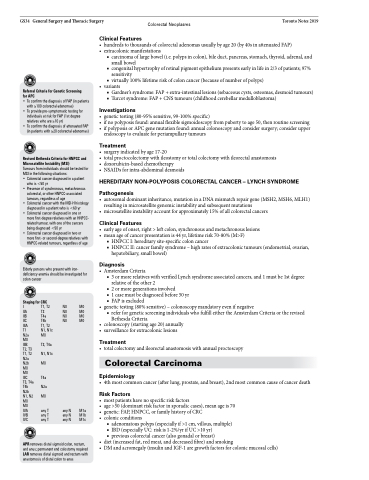Page 436 - TNFlipTest
P. 436
GS34 General Surgery and Thoracic Surgery Colorectal Neoplasms Toronto Notes 2019
Referral Criteria for Genetic Screening
for APC
• To confirm the diagnosis of FAP (in patients
Clinical Features
• hundredstothousandsofcolorectaladenomasusuallybyage20(by40sinattenuatedFAP) • extracolonicmanifestations
■ carcinoma of large bowel (i.e. polyps in colon), bile duct, pancreas, stomach, thyroid, adrenal, and small bowel
■ congenital hypertrophy of retinal pigment epithelium presents early in life in 2/3 of patients; 97% sensitivity
■ virtually 100% lifetime risk of colon cancer (because of number of polyps) • variants
■ Gardner’s syndrome: FAP + extra-intestinal lesions (sebaceous cysts, osteomas, desmoid tumours) ■ Turcot syndrome: FAP + CNS tumours (childhood cerebellar medulloblastoma)
with ≥100 colorectal adenomas)
• To provide pre-symptomatic testing for Investigations
individuals at risk for FAP (1st degree
relatives who are ≥10 yr)
• To confirm the diagnosis of attenuated FAP
(in patients with ≥20 colorectal adenomas)
Revised Bethesda Criteria for HNPCC and Microsatellite Instability (MSI)
Tumours from individuals should be tested for MSI in the following situations:
• Colorectal cancer diagnosed in a patient who is <50 yr
• genetictesting(80-95%sensitive,99-100%specific)
• ifnopolyposisfound:annualflexiblesigmoidoscopyfrompubertytoage50,thenroutinescreening • ifpolyposisorAPCgenemutationfound:annualcolonoscopyandconsidersurgery;considerupper
endoscopy to evaluate for periampullary tumours
Treatment
• surgeryindicatedbyage17-20
• totalproctocolectomywithileostomyortotalcolectomywithileorectalanastomosis • doxorubicin-basedchemotherapy
• NSAIDsforintra-abdominaldesmoids
HEREDITARY NON-POLYPOSIS COLORECTAL CANCER – LYNCH SYNDROME
• Presence of synchronous, metachronous
colorectal, or other HNPCC-associated Pathogenesis
tumours, regardless of age
• Colorectal cancer with the MSI-H histology
diagnosed in a patient who is <60 yr
• Colorectal cancer diagnosed in one or
more first-degree relatives with an HNPCC- related tumour, with one of the cancers being diagnosed <50 yr
• Colorectal cancer diagnosed in two or more first- or second-degree relatives with HNPCC-related tumours, regardless of age
Elderly persons who present with iron- deficiency anemia should be investigated for colon cancer
• autosomaldominantinheritance,mutationinaDNAmismatchrepairgene(MSH2,MSH6,MLH1) resulting in microsatellite genomic instability and subsequent mutations
• microsatelliteinstabilityaccountforapproximately15%ofallcolorectalcancers
Clinical Features
• earlyageofonset,right>leftcolon,synchronousandmetachronouslesions • meanageofcancerpresentationis44yr,lifetimerisk70-80%(M>F)
■ HNPCC I: hereditary site-specific colon cancer
■ HNPCC II: cancer family syndrome – high rates of extracolonic tumours (endometrial, ovarian,
hepatobiliary, small bowel)
Diagnosis
• AmsterdamCriteria
■ 3 or more relatives with verified Lynch syndrome associated cancers, and 1 must be 1st degree
relative of the other 2
■ 2 or more generations involved
■ 1 case must be diagnosed before 50 yr ■ FAP is excluded
• genetic testing (80% sensitive) – colonoscopy mandatory even if negative
■ refer for genetic screening individuals who fulfill either the Amsterdam Criteria or the revised
Bethesda Criteria
• colonoscopy (starting age 20) annually • surveillance for extracolonic lesions
Treatment
• total colectomy and ileorectal anastomosis with annual proctoscopy
Colorectal Carcinoma
Epidemiology
• 4th most common cancer (after lung, prostate, and breast), 2nd most common cause of cancer death
Risk Factors
• most patients have no specific risk factors
• age>50(dominantriskfactorinsporadiccases),meanageis70 • genetic:FAP,HNPCC,orfamilyhistoryofCRC
• colonicconditions
■ adenomatous polyps (especially if >1 cm, villous, multiple) ■ IBD (especially UC: risk is 1-2%/yr if UC >10 yr)
■ previous colorectal cancer (also gonadal or breast)
• diet(increasedfat,redmeat,anddecreasedfibre)andsmoking
• DMandacromegaly(insulinandIGF-1aregrowthfactorsforcolonicmucosalcells)
Staging for CRC
I
IIA
IIB
IIC
IIIA
T1 N2a M0 IIIB
T2, T3 T1, T2 N2a N2b M0 M0 IIIC
T3, T4a T4b N2b N1, N2 M0 M0 IVA IVB IVC
T1, T2 T3
T4a T4b
T1, T2 N1, N1c M0
T3, T4a N1, N1c M0
T4a N2a M0
anyT anyT anyT
N0 M0 N0 M0 N0 M0 N0 M0
anyN M1a anyN M1b anyN M1c
APR removes distal sigmoid colon, rectum, and anus; permanent end colostomy required LAR removes distal sigmoid and rectum with anastomosis of distal colon to anus


